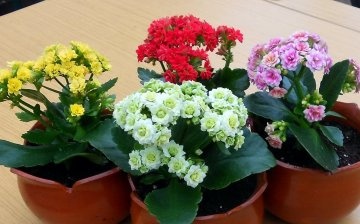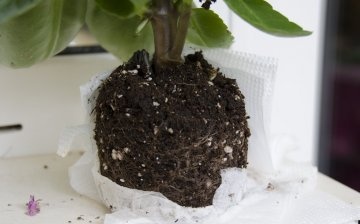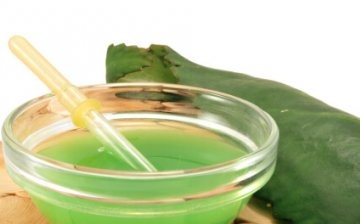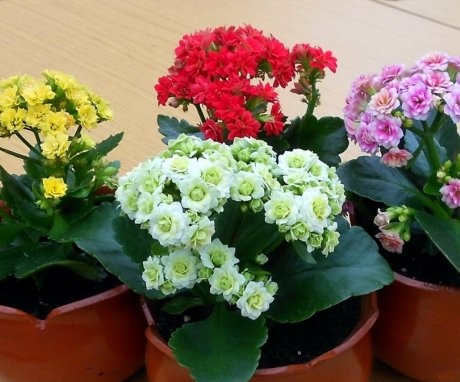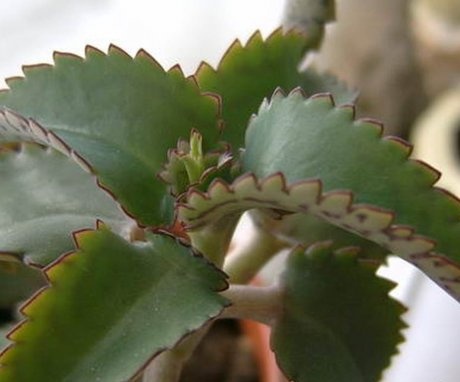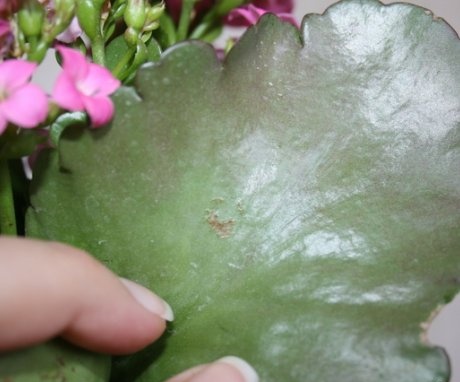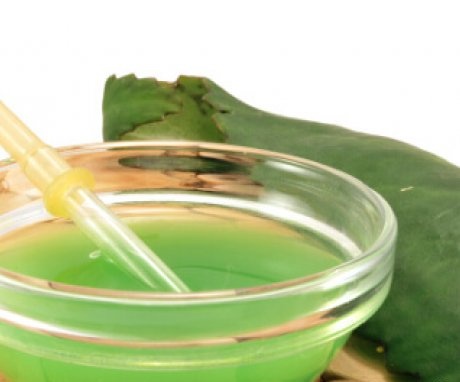How to transplant Kalanchoe: terms and rules
Succulents have firmly won the hearts of gardeners with their endurance, unpretentiousness, and interesting appearance. They are distinguished by the fleshyness of the leaves, hence the name of the group of plants. Sukkus from Greek - juice, juicy. Kalanchoe - one of the most popular succulents of the Tolstyankov family.
Kalanchoe is known as a plant with medicinal properties. There are more than two hundred species of herbaceous perennial. It is grown for decorative purposes, used in the treatment of many human diseases. You can buy a flower in specialized stores. It is better to make a purchase in winter during the flowering of the Kalanchoe. After that, it is necessary to transplant the indoor flower, creating favorable conditions for its growth and development.
Content:
- Kalanchoe - description of plant species
- Terms and rules for transplanting a succulent
- Features of care after transplant
- Diseases and pests of Kalanchoe, the fight against them
- Useful properties of the plant, their use in medicine
Kalanchoe - description of plant species
The appearance of an indoor succulent is not particularly beautiful. On a straight, thick stem, opposite leaves are located, thick, juicy. The color of leaf plates of different shapes varies from green to reddish.
The plant blooms for a long time, covered with small inflorescences, collected in panicles or umbrellas.
Types of Kalanchoe:
- Of the most common types of succulents, the Blossfeld Kalanchoe is considered with a stem height of thirty to forty centimeters. It has rounded small leaves, semi-umbellate inflorescences of red, purple, orange tones.
- The felt type of plant is characterized by oblong leaves covered with white fluff. No wonder they call it cat ears. The species rarely blooms.
- In Degremona, large, elliptical-like, slightly curled leaves have decorative and medicinal properties. Outside, they are green with a grayish tint, and inside - in purple spots.
- On the strong fleshy trunk of the Kalanchoe pinnate, or Bryophyllum, thick triangular leaves, juicy, with denticles along the edges. In the second year of life, the plant blooms, but paniculate inflorescences do not appear every year.
Almost all types of Kalanchoe have medicinal properties to a greater or lesser extent.
Terms and rules for transplanting a succulent
The Kalanchoe should be transplanted after the purchase of the plant, if it develops fungal diseases, when it stops in growth, it withers. The procedure should not be too frequent, it is enough to transplant the indoor flower into a new pot once a year. This is done in the spring, when the culture stops blooming. There are certain rules for transplanting a plant:
- Capacity for kalanchoe must be selected taking into account the fact that it will be two centimeters larger in the diameter of the old pot.
- The inner walls of the flowerpot are washed with soapy water or simply doused with boiling water. You can disinfect the pot with a solution of potassium permanganate or copper sulfate.
- The drainage layer fills the container by a quarter. It consists of expanded clay, coarse sand or pottery shards.
- Then the container is filled by three quarters with a nutrient mixture for succulents purchased from the store, or composed independently of four parts of peat, two parts of turf and one of sand. The soil is pre-steamed with boiling water or in an oven at a temperature of thirty degrees.
- The transplant begins by carefully removing the plant from the old container, leaving clods of earth on the roots. Then the soil is carefully removed the roots, followed by rinsing them with warm running water. Having examined carefully the underground parts of the flower, the decayed part of the roots is removed.
- The Kalanchoe is placed in a new container, covered with soil so that the root collar remains level with the soil.
- After the end of the procedure, the soil is compacted with the tip of the peg, and the flower is watered.
To reduce the stress from transplanting, the plant needs to be sprayed with warm water, shading from bright sunlight. At first, the Kalanchoe will look lethargic, but after the final engraftment, it will strengthen, overgrowing with new leaves.
Features of care after transplant
Having transplanted a perennial, it is necessary to create comfortable conditions for it for further development:
- The aggressiveness of the sun's rays is dangerous for the succulent. Therefore, a place with diffused light is chosen for him.
- For a flower, air temperature does not really matter. It tolerates heat well over twenty-five degrees, and low temperatures of ten degrees Celsius.
- Do not over-water the plant. It will be enough two or three times a week. Increase the frequency of soil moistening on hot days, and reduce - in winter.
- Spraying is harmful to the crop. Leaves can be wiped with a dry cloth, free of dust.
- The plant is fed during the growing season with special mineral complexes for succulents.
- The emergence of a large number of young shoots is ensured pruning dried inflorescences to the base.
Proper care is necessary for the Kalanchoe, then the houseplant will look vigorous, beautiful, delight with green leaves and bright flowers.
Diseases and pests of Kalanchoe, the fight against them
Fungal diseases in the form of rot, powdery mildew often affect perennials. This is due to increased soil moisture, air, improper lighting. The leaves suffer from the disease, covered with gray or black spots, a whitish bloom. At the same time, they fall off.
Help fight fungi fungicidal preparations, with which parts of the plant are sprayed three times with a break of ten days.
If rings appear on the leaves of the Kalanchoe, and they lose their shape, become tough, then a dangerous virus has struck the culture. It will not be possible to save the perennial; you will have to get rid of it.
The pests that have settled on the succulent include ticks, aphids, scale insects, mealybugs:
- The tick is characterized by leaving brown crusts on the leaves. The flower stops developing, begins to wither. You can get rid of the parasite by washing the leaves with a solution of laundry soap.
- Aphids recognized by a sticky yellowish bloom on the leaves. Spraying with insecticides will help destroy the pest.
- The shield can only be washed off the leaves with a swab dipped in alcohol. Removing insects by hand will also be effective.
- The mealybug affects the Kalanchoe, covering the leaves with a whitish bloom. Treatment with insecticidal agents will save him from it.
Taking care of the Kalanchoe will preserve the health of the plant and prevent the appearance of pests.
Useful properties of the plant, their use in medicine
Kalanchoe juice is known for its beneficial properties. It is used in the manufacture of drugs for the surgical, dental, ophthalmic, obstetric-gynecological, otolaryngological areas of medicine.
A storehouse of organic acids, flavonoids, tannins, vitamins is hidden in the green leaves of the plant. Kalanchoe juice heals wounds, ulcers, bedsores.It helps to stop purulent processes in the tissues. Juice inhalation reduces inflammation in stomatitis, periodontitis. Kalanchoe preparations heal erosion of the cervix, tears received during childbirth. Purulent ear infections, chronic tonsillitis, rhinitis can be cured with plant juice.
Perennial sap is obtained from the leaves and the herbaceous part of the stem.
Before that, they are washed under running water, kept for a week in a dark and cold room. After squeezing out the juice, it is defended for one to three days at a temperature not exceeding ten degrees Celsius. After straining it can be used by digging it into the nose for colds, ear for otitis media. Gruel from fresh leaves, applied in the form of compresses, stop bleeding, relieve toothache.
The juice of the plant is rubbed with places affected by acne, eczema. For the treatment of boils, purulent wounds, panaritiums, an ointment made from 60 grams of lanolin, 40 grams of Kalanchoe juice, 0.25 each of novocaine and furazolidone is used. The carefully mixed components are used for healing dressings on the affected areas. It is not recommended to take Kalanchoe juice internally - it causes heartburn, diarrhea. The benefits of perennials have been known for a long time, but not all types of it are medicinal.
More information can be found in the video:




